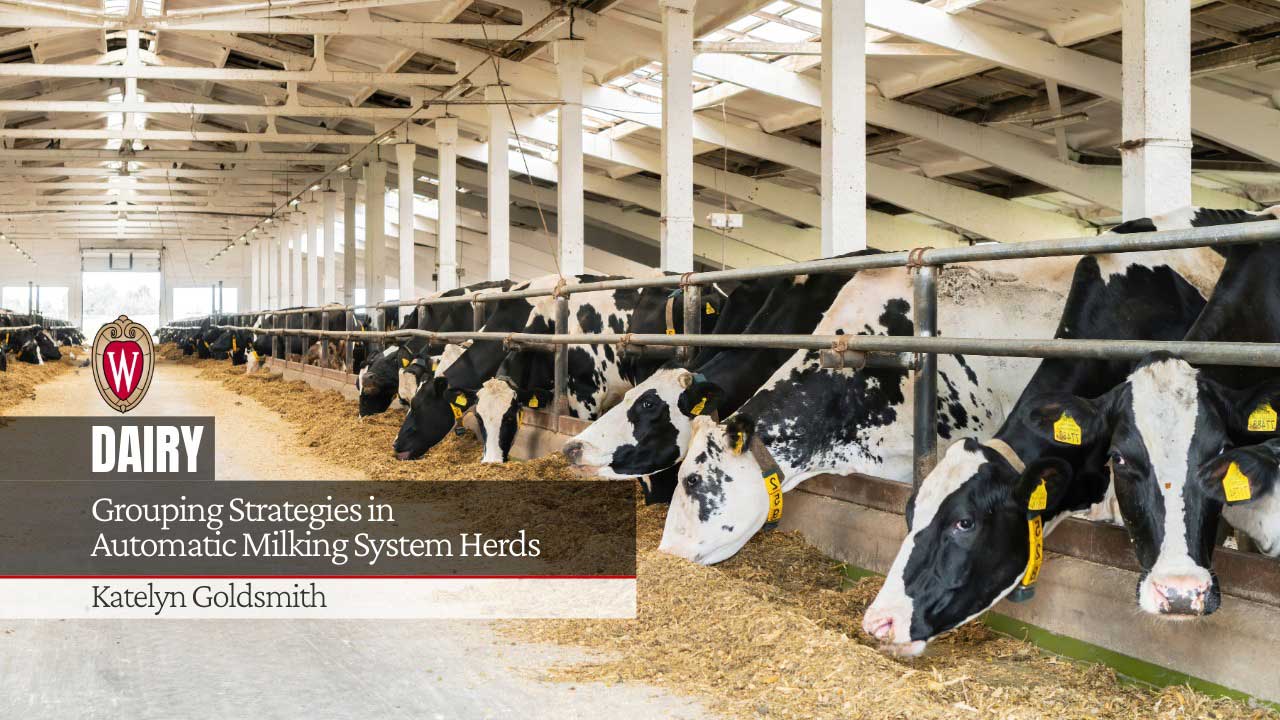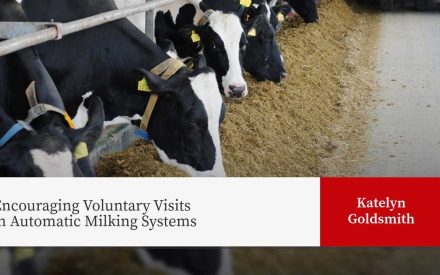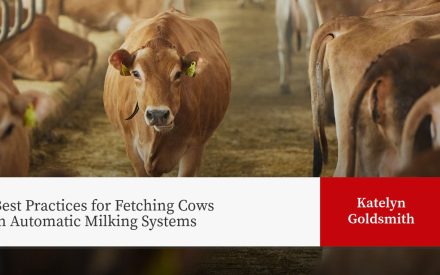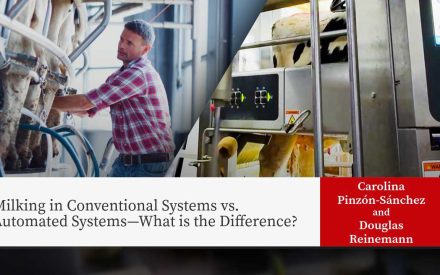
Introduction
How cows are grouped plays an important role in dairy herd management. In barns with Automatic Milking Systems (AMS) 🔍, thoughtful grouping strategies can help improve cow flow, increase robot efficiency, manage feed costs, and support management goals. Just as in conventional housing systems, AMS herds can benefit from evaluating which grouping approaches work best for their operation. This article outlines common strategies used in AMS barns and their benefits and tradeoffs.
Mixed-Group
In a mixed-group strategy, cows of all production levels, stages of lactation, ages, and sizes are housed together. Cows typically enter this pen after calving and remain there until dry-off. This approach eliminates the need to move cows between pens during lactation, limiting disruptions to social groups and negative effects on production and behavior. It also minimizes labor needed to regroup animals.
A mixed group helps balance robot use throughout the day, especially when pens are stocked at typical cow to AMS ratios 🔍 (50-60 cows/AMS). However, it presents challenges for ration formulation. High-producing cows require greater energy and nutrient intake, while late-lactation cows can often be maintained on lower-energy, lower-cost diets. Feeding all cows the same partial mixed ration (PMR) 🔍 creates a nutritional balancing act. Feeding to meet the needs of top producers can lead to overfeeding and weight gain in lower-producing cows, while formulating to the average may limit the performance of high producers. This may be partially alleviated by targeted AMS concentrate 🔍 feeding, but not entirely. Additional AMS concentrate can be provided to offset a lower energy PMR, but this can be limited by cow intakes and economic feasibility.
For smaller farms or those with limited infrastructure, the mixed-group strategy may be the only practical option.
Milk Production Level
Grouping cows by milk production allows for diets to be formulated to better match the nutritional needs of each production group. This can support the production of high-performing cows while managing weight gain and feeding costs in lower producing cows. However, this strategy requires cows to be moved between groups as well as feeding multiple rations. Often, moving cows from high to lower energy diets results in drops in milk yield. The extent of this drop varies by farm depending on conditions such as ration formulation and environmental factors. Therefore, the economic benefit of moving cows to low diets depends on whether the decreased feed costs outweigh the potential production loss (1).
Grouping cows by production often requires adjusting AMS stocking densities to maintain consistent cow flow to the robot. AMS herds typically stock around 50-60 cows per robot, but this may need to vary based on expected visit frequency 🔍. For instance, high production cows may visit the robot four times per day while low-producing, late lactation cows may only visit twice. Pens with cows that milk more frequently may need to be stocked with fewer cows per AMS, while those with less frequent milkings can often accommodate more cows.
Given these complexities, grouping by production level is most successful when farmers and nutritionists routinely evaluate ration costs, monitor milk production and body condition score (BCS), and assess the overall economic return of the strategy. Additionally, farms should continually evaluate robot use and efficiency to determine if stocking densities should be adjusted.
Days In Milk (DIM)
In conventional barns, grouping cows by days in milk is an approach to simplify routine management tasks. For example, having all breeding-eligible cows (based on DIM) in one pen makes it easier for breeders to complete their task without needing to sort through multiple pens. This grouping approach can reduce labor, time spent sorting and handling cows, and minimize time cows spend in headlocks. Since DIM often aligns with milk production, farms can combine both grouping strategies to capture the benefits of each.
A separation pen 🔍 may accomplish the same management benefits as grouping by DIM. A separation pen is a designated area where cows can be automatically sorted after milking. These pens, whether permanent or temporary, allow farmers to sort off individual animals for tasks like breeding or dry-off without locking up or disrupting the entire group. Separation pens are most practical when working with a small number of cows each day. They may be less sensible when large groups need to be sorted, such as during hoof trimming or large herd health checks. Additionally, like grouping by milk production, grouping cows by DIM often requires adjusting AMS stocking densities to maintain consistent cow flow to the robot.
Grouping by DIM in AMS herds may be most relevant for fresh cows. A dedicated fresh cow group allows for close monitoring during the postpartum period, reduces social competition from dominant cows, and enables feeding a specific fresh cow diet.
Age
Another common grouping strategy is separating first-lactation cows from older, larger cows. Younger and smaller cows are typically more submissive in the barn’s social hierarchy. This can be more severe in AMS herds during early lactation when first-lactation animals are still learning the system. Research studies have shown that in mixed-lactation AMS groups, first lactation cows spend more time waiting to use the AMS compared to older cows (2).
Grouping by age helps create a more equitable social environment which can improve access to the robot and reduce stress. It also maintains a balanced distribution of lactation stages across the pen, helping to maintain consistent robot flow at typical AMS stocking densities. However, this approach shares a key limitation with the mixed-group model – the need to formulate a diet that accommodates cows at different stages of lactation and production.
Special Needs
Many AMS farms choose to designate a special needs group 🔍 for cows that require extra attention. This pen may serve multiple roles such as housing fresh cows, lame cows, or sick cows. In most cases, it is a smaller pen located adjacent to the main pen and shares access to the same AMS units. The location and design of a special needs pen can offer several benefits. By minimizing walking distance to the robot, it makes it easier for lame or sick cows to maintain milking frequency. These pens may also be built with alternative lying surfaces such as straw packs, which can be more comfortable for lame animals (3). Research has shown that straw packs placed near the robot can increase milk production per robot (4). These pens could also serve as a separation pen as needed.
While special needs pens require additional investment in infrastructure, they can offer flexibility for managing cow health without compromising AMS efficiency.
Regrouping Considerations in AMS
When cows are moved between groups, they must adjust to a new social group. Research suggests that the negative effects of regrouping are generally short-term. In conventional freestall herds, the most noticeable behavioral change after a move is increased competition at the feed bunk on the first day, followed by a gradual return to normal behavior over the next few days (5). This increased competition can lead to minor drops in milk production. A review of parlor-milked herds found that milk losses due to regrouping ranged from none to about 5% (6). Regrouping may have a greater impact on milk production in AMS herds where cows may compete for robot access, compared to parlor herds where milking is not competitive. However, given the system’s ability to track individual milk production, AMS herds are well-positioned to identify pen move effects on their farm.
Summary of Common Grouping Strategies
| Strategy | Advantages | Considerations |
|---|---|---|
| Mixed Group | Simplifies management by eliminating pen moves. Maintains consistent cow flow to robot with typical stocking rates. | Diet must accommodate a wide range of needs. Social hierarchy may disadvantage smaller or younger cows. |
| Milk Production Level | Allows tailored rations and management to align with production. This may support milk production or optimize feed costs. | Requires multiple rations and pen moves. Potential for a drop in milk yield when moved to lower energy diets which may offset feed cost savings. May need to adjust AMS stocking densities. |
| Days in Milk | Allows tailored rations and management, especially for fresh cows. Can streamline management tasks. | Requires multiple pen moves. May need to adjust AMS stocking densities. Some of these benefits can be achieved with separation pens. |
| Age | Reduces social competition and stress for first lactation cows. | Diet must accommodate a wide range of needs. |
| Special Needs | Supports cow health and management with minimal disruption to AMS flow. Improved comfort and access to AMS for special need cows. | Requires special infrastructure and management. |
Summary
Different grouping strategies offer various advantages and limitations, and what works best for your farm will depend on factors like herd size, facility layout, and labor capacity. Farms may choose to implement a single approach or combine several to align with their goals. When thoughtfully applied, grouping can help improve overall efficiency in farm operations and management.
Author

Katelyn Goldsmith
Dairy Outreach Specialist– In her role as a statewide Dairy Outreach Specialist, Katelyn connects research with practical farm management practices to create educational programming addressing the needs of Wisconsin dairy producers.
References
- Bach, A. 2023. Changes in milk production and estimated income over feed cost of group-housed dairy cows when moved between pens. Journal of Dairy Science, 106:4108-4120. https://doi.org/10.3168/jds.2022-22875
- Solano, L., Halbach, C., Bennett, T.B., & Cook, N.B. 2022. Milking time behavior of dairy cows in a free-flow automated milking system. JDS Communications, 3:426-430. https://doi.org/10.3168/jdsc.2022-0243
- Solano, L., Barkema, H.W., Pajor, E.A., Mason, S., LeBlanc, S.J., Zaffino Heyerfodd, J.C., Nash, C.G.R, Haley, D.B., Vasseur, E., Pellerin, D., Rushen, J., de Passille, A.M., & Orsel, K. 2015. Prevalence of lameness and associated risk factors in Canadian Holstein-Friesian cows housed in freestall barns. Journal of Dairy Science, 98:6978-6991. https://dx.doi.org/10.3168/jds.2015-9652
- Heurkens, D., Kamphuis, C., & van der Kamp, A.J. 2016. Effects of free-stall barn layout on efficiency of Dutch dairy farms with an automatic milking system. Proc. Precision Dairy Farming 2016, Leeuwarden, the Netherlands, Wageningen Academic Publishers, Wageningen, the Netherlands (2016), pp. 157-162. Access online at https://brill.com/edcollchap/book/9789086868292/BP000026.xml
- von Keyserlingk, M.A.G., Olenick, D., & Weary, D.M. 2008. Acute behavioral effects of regrouping dairy cows. Journal of Dairy Science, 91:1011-1016. https://doi.org/10.3168/jds.2007-0532
- Cabrera, V.E., & Kalantari, A.S. 2016. Economics of production efficiency: Nutritional grouping of the lactating cow. Journal of Dairy Science, 99:825-841. https://dx.doi.org/10.3168/jds.2015-9846


 Encouraging Voluntary Visits in Automatic Milking Systems
Encouraging Voluntary Visits in Automatic Milking Systems Best Practices for Fetching Cows in Automatic Milking Systems
Best Practices for Fetching Cows in Automatic Milking Systems Milking in Conventional Systems vs. Automated Systems—What is the Difference?
Milking in Conventional Systems vs. Automated Systems—What is the Difference? Udderly Essential AMS Maintenance Tips
Udderly Essential AMS Maintenance Tips


